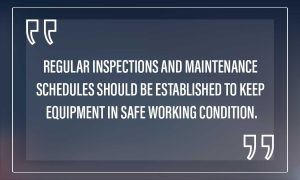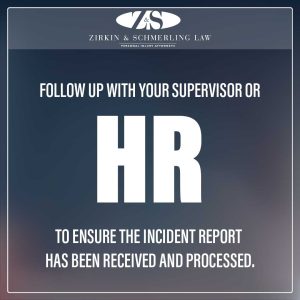
All employees have the right to a safe workplace. Whether a company has six employees or 600, employers must exercise reasonable caution regarding potential workplace hazards.
Creating a safe work environment requires proactively identifying and reducing risk factors, maintaining equipment, and training staff to stay safe. Unfortunately, some employers fail to create a safe working environment, and people get hurt.
Safe working environment examples include:
- Providing employees with protective gear
- Ensuring equipment is properly maintained
- Conducting fire drills
- Ergonomic workspaces
- Eliminating trip and slip hazards to reduce falls

If you sustain an injury while on the job, you have the legal right to contact an accident attorney to discuss your situation. Zirkin & Schmerling’s Baltimore accident lawyers can file a temporary or permanent disability claim on your behalf and help you win compensation for accident-related losses. Your accident lawyer can also investigate the incident to determine whether your employer may have neglected basic safety protocols.
How Can Employers Create Safe Working Environments?
Several key characteristics that contribute to creating and maintaining a safe workplace include:

- Clear policies and procedures: Clear and comprehensive safety policies and procedures are not just guidelines. Good policies and procedures cover hazard identification, emergency procedures, and personal protective equipment (PPE) usage, ensuring employees are well-informed and prepared for any situation.
- Regular training and education: Ongoing training and education on workplace safety topics are essential for ensuring employees understand potential hazards and know how to mitigate risks effectively.
- Effective communication: Open and effective communication channels between management and employees are crucial for promptly identifying and addressing safety concerns. Employees should feel confident reporting hazards or unsafe conditions without fear of reprisal.
- Safety inspections and audits: Regular safety inspections and audits help you identify potential hazards before they happen. Trained personnel should regularly assess equipment, facilities, and work practices thoroughly.
- Proper equipment and maintenance: Providing employees with appropriate safety equipment and ensuring that machinery and tools are correctly maintained are essential for preventing accidents and injuries. Regular inspections and maintenance schedules should be established to keep equipment in safe working condition.
- Employee involvement: Encouraging employee involvement in safety initiatives creates safety within the organization and encourages people to pay attention to their surroundings. Employees should actively identify hazards, develop safety protocols, and participate in safety committees or meetings.
Essential Information to Include in the Incident Report
Creating a safe working environment requires employers to create an easy but thorough reporting process. The best safety reports help supervisors identify the cause of an incident and implement changes to prevent it from happening again.
Vital information to report includes:
- Date, time, and location of the incident
- Names and contact information of individuals involved
- Description of what happened, how it occurred, and who saw it
- Details of any injuries or property damage sustained
- Contributing factors or hazards that may have caused or contributed to the incident
- Actions taken to address immediate safety concerns or mitigate risks
- Names and statements of any witnesses to the incident
- Any medical treatment provided or sought for injuries
- Name of the staff notified and date/time of notification
- Recommendations for preventing similar incidents in the future
- Industry-specific information (like the temperature of an oven that malfunctioned or ingredients in a dangerous solution that spilled)
Consistent Procedures for Incident Reporting Create Safe Working Environments
Accidents can still occur regardless of the precautions a company takes to promote a safe work environment. Human resource departments must make reporting procedures accessible for employees and encourage them to report any potential hazards they notice in the workplace.
Here are a few key steps a safe work environment incident reporting process includes:

- Seek medical attention: If anyone is injured, seek medical attention promptly. Provide first aid as needed and arrange for professional medical treatment if necessary.
- Secure the area: If necessary, secure the area to prevent further accidents or injuries. Use caution tape, barriers, or signage to mark off the area and ensure the safety of others.
- Notify supervisor or manager: Creating a safe working environment requires immediately informing your supervisor or manager about the incident providing details of what happened and any injuries sustained.
- Document the incident: Record essential details of the incident, including the date, time, and location, as well as a description of what happened and any contributing factors. Take photographs if possible.
- Collect witness statements: Obtain statements from any witnesses to the incident, including names, job titles, contact information, and a detailed account of what they saw or heard.
- Complete incident report form: Fill out an incident report form provided by your employer or HR department. Include all relevant information about the incident, injuries, property damage, and any corrective actions taken.
- Submit a report to HR or safety officer: Submit the completed incident report to the appropriate person or department responsible for handling workplace safety issues, such as HR or the safety officer.
- Follow up: Follow up with your supervisor or HR to ensure the incident report has been received and processed. Provide any additional information or assistance as needed to reestablish your workplace as a safe work environment.
Regular Review of Incidents By a Dedicated Team
Workplace incidents that need to be reported and reviewed typically include any event or situation that could result in injury, illness, or property damage.
The type of incidents that need to be reviewed vary depending on the industry and specific workplace, but common examples include:
- Injuries: Staff should report any work-related injuries, regardless of severity. This includes cuts, burns, strains, sprains, fractures, and other physical injuries sustained on the job.
- Illnesses: Work-related illnesses or health conditions should also be reported. Exposure to hazardous substances, respiratory conditions, repetitive stress injuries, and other health issues related to workplace conditions should be reported.
- Near misses: Near misses, or incidents where an accident almost occurred but was narrowly avoided, should be reported and investigated to identify underlying hazards and prevent future incidents.
- Property damage: Damage to equipment, machinery, vehicles, or other property should be reported, particularly if it poses a safety risk or affects the functionality of essential tools or resources.
- Environmental incidents: Incidents involving environmental hazards, such as spills, leaks, or releases of hazardous substances, should be reported to prevent harm to employees, the public, or the environment.
- Safety hazards: To create a safe working environment, any unsafe conditions or hazards in the workplace, such as faulty equipment, inadequate lighting, slippery floors, or blocked emergency exits, should be reported.
- Violent or aggressive behavior: Incidents involving violence, threats, harassment, or other forms of aggressive behavior in the workplace should be reported to ensure the safety and well-being of employees.
- Regulatory requirements: Additionally, industry-specific workplace incidents may be subject to reporting requirements mandated by local, state, or federal regulations.
Employer Failed to Create a Safe Work Environment? Zirkin & Schmerling Law Can Help
A workplace injury shouldn’t ruin your life. We can ensure you receive the full benefits you deserve with the help of our Maryland workers’ compensation lawyers.
We are here to help you with the legal process while you recover from your accident. Don’t go at it alone. We’ve got your back.
Contact us online or call (410) 753-4611 to schedule a free consultation today to discuss your workplace injury.
